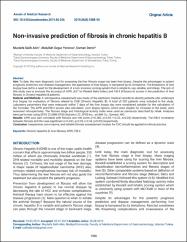| dc.contributor.author | Akın, Mustafa Salih | |
| dc.contributor.author | Yeniova, Abdullah Özgür | |
| dc.contributor.author | Demir, Osman | |
| dc.date.accessioned | 2020-02-27T07:51:40Z | |
| dc.date.available | 2020-02-27T07:51:40Z | |
| dc.date.issued | 2019 | en_US |
| dc.identifier.citation | Akın, M. S., Yeniova, A. Ö. ve Demir, O. (2019). Non-invasive prediction of fibrosis in chronic hepatitis B. Annals of Medical Research, 26(8), 1588-1593. http://doi.org/10.5455/annalsmedres.2019.05.256 | en_US |
| dc.identifier.issn | 2636-7688 | |
| dc.identifier.uri | http://doi.org/10.5455/annalsmedres.2019.05.256 | |
| dc.identifier.uri | https://hdl.handle.net/20.500.12511/4965 | |
| dc.description.abstract | Aim: To date, the main diagnostic tool for assessing the liver fibrosis stage has been liver biopsy. Despite the advantages in patient prognosis prediction and disease management, the application of liver biopsy is hampered by its limitations. The limitations of liver biopsy have led to a need for the development of a non- invasive scoring system that is simple to use, reliable, and cheap. The aim of this study was to evaluate the accuracy of APRI (AST to Platelet Ratio Index) and FIB-4 (Fibrosis-4) scores in the prediction of liver fibrosis in Chronic Hepatitis B patients. Material and Methods: A retrospective assessment was made of the electronic medical records to identify patients who underwent liver biopsy for evaluation of fibrosis related to CHB (Chronic Hepatitis B). A total of 352 patients were included in the study. Laboratory parameters that were measured within 7 days of the liver biopsy day were considered suitable for the calculation of the formulae. The APRI and FIB-4 scores was calculated. Liver biopsy reports, which were eligible for inclusion in the study, were assessed retrospectively. The fibrosis stage and histological acitvity index were used as previously described by Ishak. Analyses were performed using SPSS 22 (IBM SPSS Statistics 22, SPSS inc., an IBM Co., Somers, NY). Results: APRI was well correlated with fibrosis and HAI score (r=0.280, p<0.05; r=0.22, p<0.05) respectively. The FIB-4 correlation between fibrosis and HAI was significant (r=0.433, p<0.05; r=0.34, p<0.05) respectively. Conclusion: Inexpensive, non-invasive, and reliable fibrosis assessement models for CHC should be applied in clinical practice. | en_US |
| dc.language.iso | eng | en_US |
| dc.rights | info:eu-repo/semantics/openAccess | en_US |
| dc.subject | Chronic Hepatitis B | en_US |
| dc.subject | Liver Fibrosis | en_US |
| dc.subject | APRI | en_US |
| dc.subject | FIB-4 | en_US |
| dc.title | Non-invasive prediction of fibrosis in chronic hepatitis B | en_US |
| dc.type | article | en_US |
| dc.relation.ispartof | Annals of Medical Research | en_US |
| dc.department | İstanbul Medipol Üniversitesi, Tıp Fakültesi, Dahili Tıp Bilimleri Bölümü, İç Hastalıkları Ana Bilim Dalı | en_US |
| dc.authorid | 0000-0002-1309-6588 | en_US |
| dc.identifier.volume | 26 | en_US |
| dc.identifier.issue | 8 | en_US |
| dc.identifier.startpage | 1588 | en_US |
| dc.identifier.endpage | 1593 | en_US |
| dc.relation.publicationcategory | Makale - Ulusal Hakemli Dergi - Kurum Öğretim Elemanı | en_US |
| dc.identifier.doi | 10.5455/annalsmedres.2019.05.256 | en_US |


















